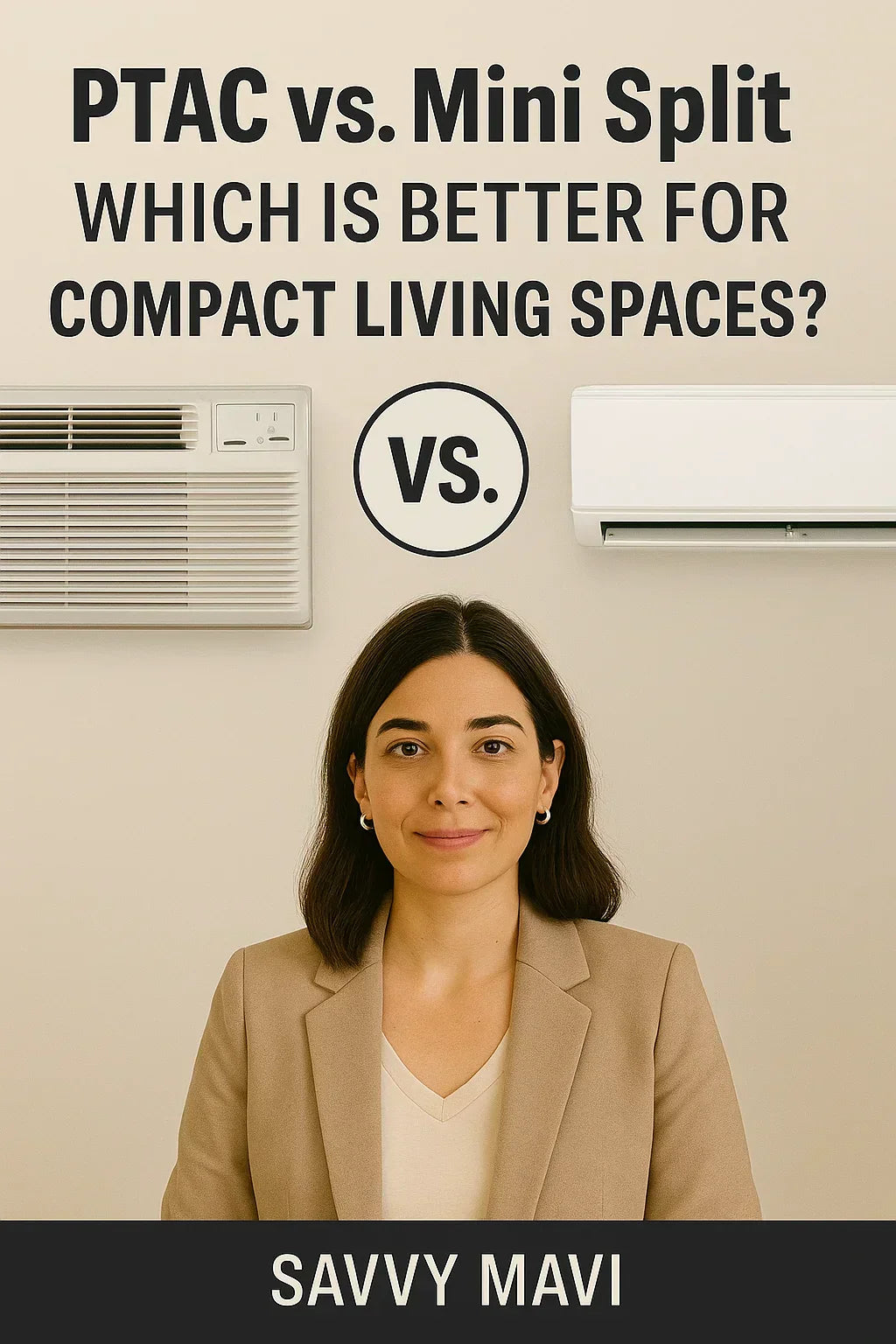Whether you’re outfitting a studio apartment, guest room, home office, or backyard ADU, the question often comes down to: PTAC or mini split? Both systems are popular solutions for efficient climate control in small to mid-size spaces. But which is truly better for compact living?
In this in-depth comparison, we’ll look at everything from installation and energy efficiency to comfort and aesthetics—with a focus on what matters most to practical buyers like Savvy, who wants quiet, affordable comfort for her small, efficient living space.
🛋 What Is a PTAC System?
PTAC (Packaged Terminal Air Conditioner) systems are all-in-one heating and cooling units installed through a wall. They are most commonly found in hotels and motels but are gaining popularity in small apartments, guest rooms, and rentals due to their affordability and self-contained design.
Key Features:
-
Installs through an exterior wall via a sleeve
-
Offers both cooling and heating
-
No ductwork required
-
Typically comes in 7,000 to 15,000 BTUs
-
Built-in controls
❄️ What Is a Mini Split System?
Mini split (ductless) HVAC systems separate the indoor air handler from the outdoor condenser. They’re known for high energy efficiency, whisper-quiet operation, and clean, modern aesthetics. Mini splits are ideal for zoned comfort and are increasingly used in whole-home retrofits and compact living scenarios.
Key Features:
-
Wall- or ceiling-mounted indoor units
-
Outdoor condenser connects via refrigerant line set
-
Available in single- or multi-zone configurations
-
SEER ratings often 18+
-
Remote and smart control capable
Example: MRCOOL DIY 12k Mini Split – fully DIY-installable and ideal for savvy homeowners
🔢 PTAC vs. Mini Split: Feature Comparison Table
| Feature | PTAC | Mini Split |
|---|---|---|
| Installation | Wall sleeve, plug-in or hardwired | Wall mount + outdoor condenser |
| Cooling Range | 7,000–15,000 BTUs | 9,000–48,000+ BTUs (multi-zone) |
| Efficiency | Moderate (9.0–12.0 EER) | High (18+ SEER typical) |
| Heating Mode | Electric or heat pump | Heat pump (often inverter-driven) |
| Noise Level | Moderate (inside compressor) | Very low (outside compressor) |
| Appearance | Bulky under-window unit | Sleek wall unit |
| Cost (Installed) | $800–$1,500 | $2,000–$5,000+ |
| Maintenance | DIY filter & coil cleaning | Occasional pro maintenance |
📈 Energy Efficiency: Who Saves More Over Time?
Mini splits have a clear advantage in energy efficiency thanks to:
-
High SEER/CEER ratings (up to 30 SEER)
-
Variable-speed inverter compressors
-
Precise temperature modulation
PTACs, while more budget-friendly upfront, tend to be less efficient due to single-speed motors and older technology.
🌬️ Noise Levels: How Quiet Is Your Comfort?
PTAC units have their entire motor and compressor inside the room, which means:
-
Noticeable operating hum
-
Blower and compressor noise
Mini splits move all major noise-producing components outside. The indoor air handler is nearly silent, typically under 25 decibels, compared to 50–60+ decibels for PTACs.
🚼 Installation: What Does It Take?
PTAC:
-
Requires a wall sleeve cutout (16" x 42")
-
220V electrical outlet or hardwiring
-
Mounts under window or low on the wall
-
DIY-friendly for those replacing an existing unit
Mini Split:
-
Wall-mounted indoor unit with lineset running through wall
-
Outdoor condenser needs space and slab or brackets
-
Drainage tubing and condensate management
-
Professional installation often required unless DIY model like MRCOOL
For renters or limited wall access, PTACs are often easier.
🌡️ Heating Capability: Which One Works Year-Round?
Both systems provide heating, but performance varies:
-
PTACs may have electric resistance heat (less efficient) or a heat pump with backup heat kit
-
Mini splits use inverter-driven heat pumps that maintain heat down to -5°F or lower in some models
For cold climates, mini splits outperform PTACs unless you're adding significant electric backup.
🏡 Aesthetics & Design: What Looks Better in a Small Space?
PTAC:
-
Bulky, visible under the window
-
Vent and grille exposed indoors
-
Industrial or commercial look
Mini Split:
-
Wall-mounted 6-12" from ceiling
-
Sleek, white design blends in
-
More residential and minimalist
In a modern studio, ADU, or tiny home, the mini split wins on visual appeal.
📊 Cost Breakdown: Upfront vs. Long-Term
| Expense | PTAC | Mini Split |
| Unit Cost | $700–$1,200 | $1,200–$2,500+ |
| Installation | $0–$500 DIY | $800–$2,000 (or DIY for MRCOOL) |
| Annual Energy Cost | Higher | Lower by 20–30% |
| Maintenance | DIY filter cleaning | Filter + occasional pro service |
Mini splits cost more up front but typically pay for themselves in 3–5 years through energy savings.
🛍️ Which Is Best for Your Space?
🏠 Studio Apartment (350 sq ft)
-
Mini split for aesthetics and quiet
-
PTAC if wall cutout already exists
🏛️ Home Office
-
Mini split: no noise, perfect for Zoom calls
🛏️ Basement or Garage Conversion
-
Mini split excels in uninsulated spaces
-
PTAC okay if budget-constrained
🏡 Airbnb or Rental Unit
-
PTAC offers easy user control, lower install cost
-
Mini split with locked remote = fewer temp complaints
✅ Final Verdict: PTAC vs. Mini Split
| Situation | Best Choice |
| Tight budget | PTAC |
| Quiet sleep environment | Mini Split |
| High-efficiency needs | Mini Split |
| Rental upgrade or hotel remodel | PTAC |
| Zoned home addition | Mini Split |
| DIY installation preferred | MRCOOL Mini Split |
Savvy's Pick: She went with the Hotpoint 7,000 BTU PTAC for her guest room and plans a mini split upgrade for her own bedroom remodel.
📄 Helpful Resources
In the next topic we will know more about: Installing a PTAC in a Tight Space: Wall Clearance, Sleeves & Power Tips







